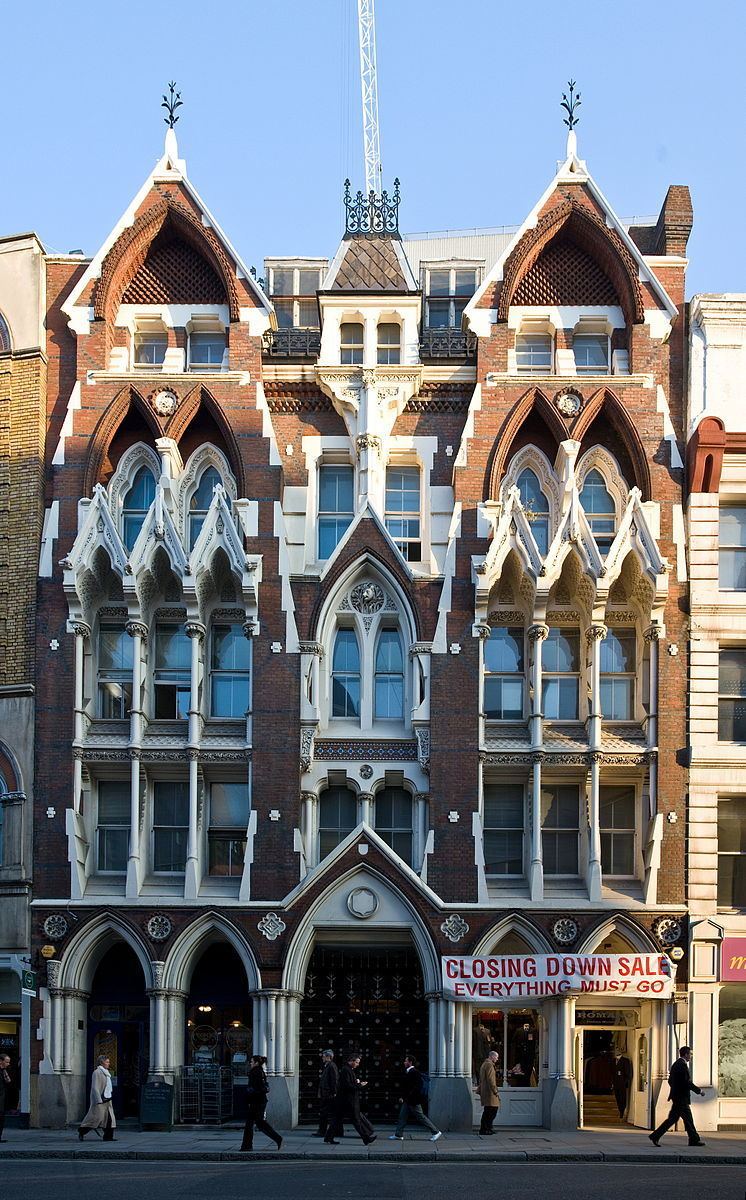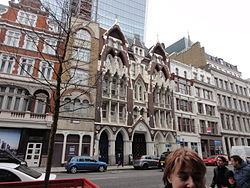Name Robert Roumieu Role Architect | ||
 | ||
Died 1877, Harrow Weald, Harrow, London, United Kingdom | ||
Robert Lewis Roumieu (1814 – 1877) otherwise R.L. Roumieu, was a 19th-century English architect whose designs include Milner Square in Islington and an idiosyncratic vinegar warehouse at 33–35 Eastcheap in the City of London. A pupil of Benjamin Dean Wyatt, he worked in partnership with Alexander Dick Gough between 1836 and 1848.
Contents
- Life and career
- Milner Square Islington
- 3335 Eastcheap
- List of other works
- Reginald St Aubyn Roumieu
- Derby connection
- References

Life and career
Roumieu was of Huguenot descent and his middle name is occasionally spelled "Louis". The Roumieu family originated from Languedoc, and the name has been listed among those of Huguenot refugees who settled in Great Britain and Ireland during the reign of Louis XIV (1643–1714). Roumieu's father John was a solicitor, while his grandfather Abraham Roumieu (1734–1780) had been an architect.
Roumieu was articled to the architect Benjamin Dean Wyatt in 1831. In 1836 he went into partnership with another pupil of Wyatt, Alexander Dick Gough. Together they completed some notable projects in what are now the London Boroughs of Camden and Islington, including Milner Square and the Islington Literary and Philosophical Institute (now the Almeida Theatre), a stuccoed classical work of 1837. The partnership was dissolved in 1848.
On 15 December 1845 Roumieu was elected a Fellow of the Royal Institute of British Architects (FRIBA), having been proposed by HL Keys, EM Foxhall, and HE Kendall.
For 22 years Roumieu's address was 10 Lancaster Place, Strand, London (1845–77). Prior to that he was at 8 Regent's Square, St Pancras, London (1845) and after that period at 7 St George's Terrace, Regent's Park, London, until his death in 1877.
Milner Square, Islington
Roumieu and Gough's Milner Square, Islington, has been taken as "an early example of his [Roumieu's] talent for strangeness and distortion."
33–35 Eastcheap
In 1868 Roumieu designed 33–35 Eastcheap in the City of London as a vinegar warehouse for Hill & Evans at a cost of £8,170. It has been seen as "crazy and dazzling" and as one of the City of London's most original commercial façades. Ian Nairn characterised it as "truly demoniac, an Edgar Allan Poe of a building", arguing that it should be preserved "not as an oddity, but as a basic part of human temperament, and one which doesn't often get translated into architecture".
Stamp and Amery praise the originality with which "the high gables broke through the standard cornice line and the confident canopies gave tremendous vigour to the façade. Describing it as "the City's masterpiece of polychromatic Gothic self-advertisement", Pevsner notes its
Red brick with blue brick bands...dressed in Tisbury stone with Devonshire marble columns, all organized into a frenzy of sharp gables, a shaft resting on top of a gable, others starting on corbels. Strictly symmetrical...twin three-bay outer sections narrow as they rise, exposing a recessed centre with a dormer in the steep roof."
The roofline is accentuated with iron foliage finials. Above the two lights of the central Gothic window Roumieu placed an animal carving in a medallion, depicting a wild boar peeping out from long grass. This alludes to the celebrated Boar's Head tavern in Eastcheap which features in Shakespeare's Henry IV plays as the scene of drunken revelry between Young Prince Hal and Falstaff.
List of other works
Roumieu's other work included:
Roumieu was also surveyor to the Gas, Light and Coke Company's Estate at Beckton, the French Hospital Estate, St Luke's, and several other estates in and near London.
Reginald St Aubyn Roumieu
Roumieu's son, Reginald St Aubyn Roumieu (1854–1921) had an architectural practice with Alfred Aitchison at his father's premises of 10 Lancaster Place, near the Strand. Roumieu and Aitchison completed R.L. Roumieu's Crosse & Blackwell warehouse designs for Charing Cross Road, following his demise in 1877, and then undertook further commissions for the firm in the same area.
Reginald St Aubyn Roumieu reflected the family's origins in becoming President of the Huguenot Society in London. In this capacity, he unveiled a memorial in 1911 to Wandsworth Huguenots. He maintained his father's association with the French Hospital, as seen by an inscribed bowl presented to him by its directors on 13 January 1921. It was sold in 2007 by the auction firm Bonhams in Edinburgh for £2,500.
Derby connection
The Roumieu family appear to have owned land in Derby which was eventually bought from them for council housing. It is recorded that 76 acres (31 ha) of land on Osmaston Park Road "were bought in 1914 from R St Aubyn Roumieu, R L Roumieu (and others) for £8000 averaging £104 per acre".
